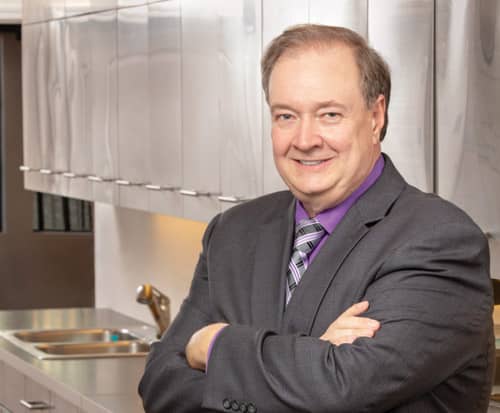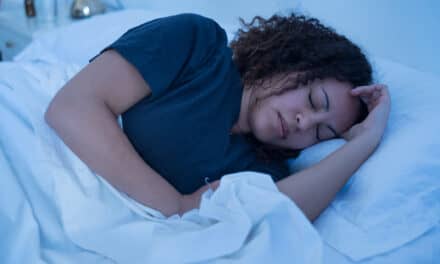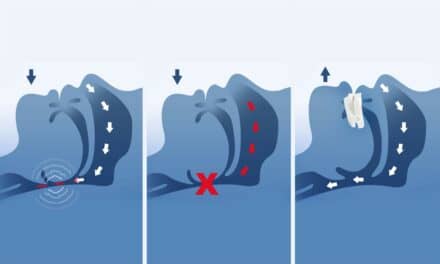By Alison Werner | Photography by Rudy Meyers
Michael B. Guess, DDS, MS, MA, set out to build a successful orthodontic practice, but along the way, he realized he needed more to keep his curiosity satisfied and his work interesting. Over the last 30 years, Guess has built an orthodontic practice that prides itself on taking a holistic approach to treating the patient. This approach has led him to incorporate not only sleep disordered breathing treatment into his practice, but also acupuncture. As a result, he has built a reputation as the orthodontist to see when there’s more to your case.
Guess was first introduced to acupuncture on a trip to China while a post-doctoral student at Ohio State University School of Dentistry. During that time, Guess worked on applying mainframe computer knowledge to orthodontics, manipulating pre-treatment photographs to estimate the final treatment outcome for patients. This work was published in the Journal of Clinical Orthodontics. Members of the Beijing Medical College were impressed by Guess’ work and invited him to visit the college. While there, Guess saw how they were using acupuncture to perform tonsillectomies with no other anesthetic. Guess was impressed not only with the outcomes but also the fact that his Chinese colleagues could point to their own studies with over 4,000 trigeminal neuralgia patients successfully treated with acupuncture. When Guess returned, he found that no one on the faculty knew anything about acupuncture. So, he put his interest in that treatment modality on the back burner, until it came time to look for an associateship. On his resume, he listed an interest in acupuncture. This caught the attention of Sacramento, Calif-based orthodontist Stanley Y. Inouye, DDS.
In the 1980s, Inouye was unsatisfied with the level of care he could provide patients with standard orthodontic treatment—especially those suffering from TMJ and the associated pain. As a result, he trained in acupuncture, attending the SAMRA University of Acupuncture in Los Angeles and completing a Bachelor of Science degree in acupuncture. He was board certified as an acupuncturist in 1987.
“Dr Inouye was a very innovative guy. He did a lot of things that we’re just now catching up with,” Guess says.
Guess worked with Inouye for 2 years, until the latter retired. It was when Inouye retired that Guess took sole ownership of the practice. Within the same year, he opened a satellite location in El Dorado Hills, which grew into a full office within a few years.
“I grew up near El Dorado Hills in Rancho Cordova—this is where my high school, junior high, my old stomping grounds are. At the time, there was nothing here, but I’ve always loved it, being here in the foothills,” Guess shares.
Guess began his formal acupuncture training at the University of California, Los Angeles (UCLA) School of Dentistry, taking an 80-hour dental acupuncture course the university offered. When he returned to the practice, Inouye brought him in to treat the jaw pain of a female patient who had come to the office in a wheelchair. Using the 85 dental acupuncture points per side of the body that regulate the jaw and teeth, Guess addressed her jaw pain successfully. Then Inouye worked on her lower body for about an hour. When Inouye was finished, Guess watched as the woman got up without help from the table and walked out of the office. No wheelchair. This occurred after one treatment. Guess was impressed, but was curious to see how she would be when they saw her again the next week. Instead her husband showed up without his wife crying. “I’m thinking, what happened? But the husband says, she didn’t want to come in. She said, ‘I’m feeling good. If I start feeling bad, then I’ll go in.’ At that point, I was hooked because I watched this lady that wasn’t very responsive turn into this vibrant person,” Guess shares.

“Computer technology changes all the time, but acupuncture doesn’t change. In acupuncture, the same points used today are the same points used 3,500 years ago. It’s a system you have to learn, but once you learn it, it’s not like a moving target,” Guess points out.
“When I first started dental acupuncture, I was the nut that did acupuncture—until I helped several dentists’ wives who were in pain. When they got better, they realized there was really something to it. A couple of dentists here in Sacramento actually came and took the acupuncture course after I helped some of their patients.”
From Acupuncture to Sleep Apnea
Guess was introduced to sleep apnea treatment in the orthodontic practice by his friend, orthodontist Stephen Tracey, DDS, MS. While Guess, through his own reading, was aware of the threat untreated obstructive sleep apnea (OSA) posed to an individual’s health and was seeing patients come into his practice for orthodontic treatment with symptoms that pointed to such a diagnosis, it wasn’t until Tracey introduced Guess to the idea of incorporating such treatment into his orthodontic practice that Guess realized he had a role to play.
“I was concerned because I had a few patients in my office, those who had asthma, who had all the signs of sleep apnea—and they were children—10, 11 years old. And that really started me thinking about how we move teeth. Because when you extract teeth, no matter what, the arches get smaller, not larger; so the tongue takes up more space. So the question for me was, how does that affect breathing?” recalls Guess.
Tracey, who passed away in 2016 and was a member of the Orthodontic Products’ Editorial Advisory Board, was well known for his incorporation of sleep disordered breathing treatment into his orthodontic practice, teaching courses on such topics as “Demystifying TMD and Sleep Medicine for the Orthodontist,” at his Upland, Calif, practice. Tracey taught orthodontists not only how to manage TMD with easy-to-fabricate-and-adjustable splints, but also how to diagnose obstructive sleep apnea, deliver and manage oral sleep appliances, and bill medical insurance for OSA treatment. In 2012, Tracey invited Guess down to his office to attend one such class.
“I spent a weekend with him, and when I got back, we immediately started applying what I learned in the office,” says Guess, who credits Tracey as a mentor.
In fact, Guess’ first patient was himself. “I wanted to know what it felt like,” says Guess, who was diagnosed with moderate sleep apnea, having an Apnea Hypopnea Index (AHI) score of 20. AHI measures the number of apneas or hypopnea events a patient has per hour during a sleep study. At the time, Guess had talked to an orthodontist friend who had undergone uvula surgery to treat his OSA. The surgery was unsuccessful. Instead, an oral appliance brought relief. Guess opted to take the appliance route from the start, treating himself with the Moses appliance. The device features an open anterior design that combined with mandibular advancement causes the tongue to protrude, enlarging the airway. With use of the oral appliance, Guess retested and his AHI score dropped to 6, classifying his OSA as mild.

Today, Guess screens all his patients. With male patients he looks at neck size. From there, a few simple questions—has anyone every complained about you snoring, have you ever been diagnosed with depression. Even a simple “How have you been?” can sometimes be enough to learn that an orthodontic patient has a problem.
“I asked this guy, how have you been doing? and he responded, ‘Well, I had another car accident.’ I told him to tell me about it and that’s how the conversation about his sleep patterns started,” recalls Guess. The patient was on his third car accident in 6 months. He was falling asleep at the wheel. The patient said he was going to bed at 8 pm every night and waking up at 7am, yet he woke up tired every morning. The patient didn’t understand why this was happening. When Guess suggested he get a polysomnogram it revealed that he was only getting about 2 hours of sleep every night. The rest of the time he was in apnea.
As Guess sees it, educating the general population about the risk sleep apnea poses to overall health is important, but so too is the need to remove the fear of seeking treatment. “As a group, a lot of truckers have issues with sleep apnea, but they’re afraid to go get tested. They’re afraid it’s going to be a problem for their employer. We need to take away that stigma that they’re concerned about so they can get treatment,” says Guess, who served as a consultant to the California Association of Orthodontists as it developed its brochures on sleep disordered breathing.
 Just the Guy to See
Just the Guy to See
Guess is not one for downtime. Golf holds no interest for him, so he instead spends his free time researching and developing homeopathic remedies. After his introduction to acupuncture, he was introduced to homeopathy. Homeopathic medicine embraces a holistic, natural approach to the treatment of the sick, according to the American Institute of Homeopathy. Instead of focusing on a diseased part or diagnosed illness, homeopathy treats the whole person, and uses remedies from natural sources, whether vegetable, mineral, or animal in nature. At first, Guess didn’t see the connection between acupuncture and homeopathy, but when he realized they were cross related, he embraced the practice fully. To date he has developed over 17 homeopathic formulas to treat among other things headaches, allergies, and cold and flu.
Guess presents himself first and foremost as an orthodontist—he doesn’t advertise himself as an acupuncturist or his treatment of sleep disordered breathing conditions; but his reputation and other expertise are often what draw people to his practice. “Like most orthodontists, my online reviews say things like he’s on time. But they also say, ‘If you have other health issues, he’s the guy to talk to because he knows a lot and is willing to share’,” says Guess, who shares the story of a patient with extreme TMJ pain.
Guess, who is referred patients from health networks, is used to seeing patients who have already racked up tens of thousands of dollars in medical bills for pain that hasn’t been alleviated. This one patient, a professional tennis player who had to leave the circuit because of her TMJ pain and vertigo, needed to get back to work. Guess first addressed her immediate pain with acupuncture. The patient was relieved because she immediately felt better. She assumed she was cured. But Guess told her no; he’d only taken care of the symptoms, now they needed to figure out the cause. After spending some talking to her about her symptoms, Guess ordered a panoramic x-ray, even though the patient said her dentist had done numerous x-rays over the years. The panoramic x-ray showed an impacted third molar. When Guess compared the most recent panoramic x-ray to one taken years before, it showed that molar was moving. The patient had the tooth removed and finally found long-term relief.
For Guess, the most satisfying patients are the ones you help and who then don’t need your help again.
 Establish Partnerships
Establish Partnerships
Whether it’s sleep medicine, acupuncture, or homeopathy, Guess advises that the best way to figure out how to incorporate any of these modalities into the practice is to make friends with other physicians offering it—especially when it comes to sleep disordered breathing treatment. As Guess sees it, sleep doctors want to focus on the hard cases, that leaves a number of less complex cases where orthodontists can fill a niche. And for orthodontists in California, where state law requires that a dental appliance be made by a dental professional, this is where a good relationship with a local sleep medicine physician can be a good partnership.
“Physicians who do sleep apnea have a depth of knowledge and they are really quite kind and will give you pointers on what they see. And if you listen to them, you’ll get up to speed very quickly,” Guess says.
As Guess sees it, treatment of sleep disordered breathing is a natural reach for orthodontists. “We do appliances all the time. [With sleep apnea], it’s just a different application for the same tools we already have a good handle on.” OP






